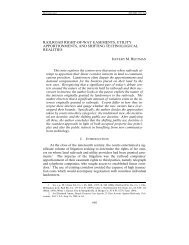on the decision to regulate hedge funds - University of Illinois Law ...
on the decision to regulate hedge funds - University of Illinois Law ...
on the decision to regulate hedge funds - University of Illinois Law ...
Create successful ePaper yourself
Turn your PDF publications into a flip-book with our unique Google optimized e-Paper software.
PAREDES.DOC<br />
9/8/2006 9:12:27 AM<br />
1000 UNIVERSITY OF ILLINOIS LAW REVIEW [Vol. 2006<br />
differently, <strong>on</strong>e can think <strong>of</strong> federal securities regulati<strong>on</strong> as addressing a<br />
“lem<strong>on</strong>s problem” that can arise in securities markets when inves<strong>to</strong>rs are<br />
unable <strong>to</strong> protect <strong>the</strong>mselves from having imperfect informati<strong>on</strong>. 99<br />
Yet, even in <strong>the</strong> name <strong>of</strong> promoting inves<strong>to</strong>r c<strong>on</strong>fidence, <strong>the</strong> SEC’s<br />
regula<strong>to</strong>ry reach is limited and does not encompass regula<strong>to</strong>ry steps designed<br />
<strong>to</strong> reduce leverage or o<strong>the</strong>rwise manage systemic risk in financial<br />
markets. 100 It should not be enough <strong>to</strong> trigger SEC interventi<strong>on</strong> in <strong>the</strong><br />
<strong>hedge</strong> fund industry when accredited inves<strong>to</strong>rs choose <strong>to</strong> invest in highly<br />
leveraged <strong>hedge</strong> <strong>funds</strong> that engage in speculative and risky trades, or<br />
when financial instituti<strong>on</strong>s c<strong>on</strong>tinue <strong>to</strong> extend credit <strong>to</strong> and execute deals<br />
with such <strong>funds</strong>, regardless <strong>of</strong> <strong>the</strong> potential inves<strong>to</strong>r and counterparty<br />
losses.<br />
More importantly, if anything, <strong>the</strong> explosi<strong>on</strong> <strong>of</strong> <strong>the</strong> <strong>hedge</strong> fund industry<br />
<strong>to</strong> a trilli<strong>on</strong> dollar business, while sharpening c<strong>on</strong>cerns over systemic<br />
risk, belies <strong>the</strong> need for SEC interventi<strong>on</strong>. M<strong>on</strong>ey c<strong>on</strong>tinues <strong>to</strong><br />
flood in<strong>to</strong> <strong>hedge</strong> <strong>funds</strong>. There is no lem<strong>on</strong>s problem leading inves<strong>to</strong>rs <strong>to</strong><br />
flee <strong>hedge</strong> <strong>funds</strong>, and <strong>the</strong> <strong>hedge</strong> fund industry does not suffer from a lack<br />
<strong>of</strong> inves<strong>to</strong>r c<strong>on</strong>fidence. To <strong>the</strong> c<strong>on</strong>trary, inves<strong>to</strong>rs might be <strong>to</strong>o c<strong>on</strong>fident<br />
investing in <strong>hedge</strong> <strong>funds</strong>. The most serious c<strong>on</strong>cern for <strong>hedge</strong> fund inves<strong>to</strong>rs<br />
is not imperfect informati<strong>on</strong> or fraud, but <strong>the</strong> increasing difficultly<br />
managers have generating risk-adjusted above-market returns—so-called<br />
99. For <strong>the</strong> classic work <strong>on</strong> <strong>the</strong> lem<strong>on</strong>s problem, see George A. Akerl<strong>of</strong>, The Market for “Lem<strong>on</strong>s”:<br />
Quality Uncertainty and <strong>the</strong> Market Mechanism, 84 Q.J. ECON. 488 (1970). For an applicati<strong>on</strong> <strong>of</strong><br />
<strong>the</strong> lem<strong>on</strong>s problem <strong>to</strong> securities regulati<strong>on</strong>, see, for example, Paredes, supra note 67, at 470–72; Edward<br />
Rock, Securities Regulati<strong>on</strong> as Lobster Trap: A Credible Commitment Theory <strong>of</strong> Manda<strong>to</strong>ry Disclosure,<br />
23 CARDOZO L. REV. 675 (2002).<br />
100. Nor, for that matter, should <strong>the</strong> SEC be in <strong>the</strong> business <strong>of</strong> regulating <strong>to</strong> prevent bubbles in<br />
any particular type <strong>of</strong> asset class or investment vehicle or <strong>to</strong> discourage speculati<strong>on</strong> (in any case, how<br />
does <strong>on</strong>e decide when a bubble exists or that <strong>the</strong>re is excessive speculati<strong>on</strong>?). Whe<strong>the</strong>r o<strong>the</strong>r authorities,<br />
such as <strong>the</strong> Federal Reserve or <strong>the</strong> Treasury Department, should play such a role is bey<strong>on</strong>d <strong>the</strong><br />
scope <strong>of</strong> this article. Notably, though, <strong>the</strong> Federal Reserve has been blamed before for fueling bubbles,<br />
such as <strong>the</strong> inflated s<strong>to</strong>ck market in <strong>the</strong> 1990s. Recently, <strong>the</strong>n-Federal Reserve Board Chairman<br />
Greenspan has recognized that <strong>the</strong> U.S. housing market has “a lot <strong>of</strong> local bubbles” that have been<br />
fueled by <strong>the</strong> Fed’s easy-m<strong>on</strong>ey policy <strong>of</strong> keeping interest rates low. See Edmund L. Andrews, Greenspan<br />
Is C<strong>on</strong>cerned About “Froth” in Housing, N.Y. TIMES, May 21, 2005, at C1; cf. Jeannine Aversa,<br />
Greenspan Builds Case for Limiting Fannie, Freddie Holdings, ASSOCIATED PRESS, May 19, 2005 (reporting<br />
that Greenspan has urged limits <strong>on</strong> <strong>the</strong> holdings <strong>of</strong> Fannie Mae and Freddie Mac <strong>to</strong> deleverage<br />
<strong>the</strong>se entities’ balance sheets, a type <strong>of</strong> substantive interventi<strong>on</strong> that Greenspan has argued<br />
against when it comes <strong>to</strong> <strong>hedge</strong> <strong>funds</strong>). For an interesting analysis <strong>of</strong> <strong>the</strong> potential role <strong>of</strong> law in preventing<br />
market crashes generally, see Frank Partnoy, Why Markets Crash and What <strong>Law</strong> Can Do<br />
About It, 61 U. PITT. L. REV. 741 (2000). See also Henry T.C. Hu, Faith and Magic: Inves<strong>to</strong>r Beliefs<br />
and Government Neutrality, 78 TEX. L. REV. 777 (2000) (analyzing what, if anything, government<br />
should do <strong>to</strong> address <strong>the</strong> prospect <strong>of</strong> bubbles in U.S. s<strong>to</strong>cks, focusing <strong>on</strong> <strong>the</strong> SEC and <strong>the</strong> Fed, and<br />
criticizing <strong>the</strong> “s<strong>to</strong>ck-based inves<strong>to</strong>r religi<strong>on</strong>” that has been fostered and that “has dis<strong>to</strong>rted market<br />
demand for s<strong>to</strong>cks”); Karmel, supra note 9 (suggesting a role for <strong>the</strong> SEC in curbing speculati<strong>on</strong>).<br />
The Supreme Court has itself limited <strong>the</strong> reach <strong>of</strong> <strong>the</strong> federal securities laws by circumscribing <strong>the</strong><br />
SEC’s regula<strong>to</strong>ry purview <strong>to</strong> disclosure-related matters, unless <strong>the</strong> relevant statute provides (or at least<br />
c<strong>on</strong>templates) o<strong>the</strong>rwise. See, e.g., Santa Fe Indus., Inc. v. Green, 430 U.S. 462 (1977); see also Paredes,<br />
supra note 67, at 423 n.17. But see Chamber <strong>of</strong> Commerce <strong>of</strong> U.S. v. SEC, 412 F.3d 133, 138–40<br />
(D.C. Cir. 2005) (presenting an arguably more expansive reading <strong>of</strong> SEC authority under <strong>the</strong> Investment<br />
Company Act).




